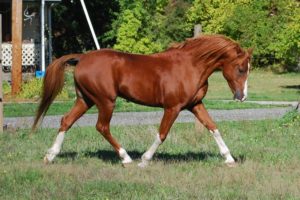Getting the Right Kind of Energy from Your Horse
by Gina Fresquez, MS, CHHC
Is your horse too slow, too fast or just right? This is a very common topic as I hear from a lot of horse owners who have trouble with the energy they get from their horse. They say things like “my horse is too hyper” or “my horse is lagging behind” and come looking to me for help. Though you do have to take the horse’s specific breed, age and personality into consideration, horse owners can actually manipulate their horse’s diet to get the desired type of energy from their horse. The key is to understand the three different energy sources for your horse and then matching them up to what your horse needs.
 Starch and Sugar
Starch and Sugar
This is a common and widely used source of energy in the horse. Starches and sugars (a carbohydrate) primarily come from whole grains, molasses, as well as some forages and pasture in the horse’s diet. Similar to humans, when starch and sugar is digested in the small intestine of the horse it is broken down into glucose and absorbed into the blood stream. There it delivers a quick burst of energy to the horse when he needs it or, if not, the release of insulin helps store the glucose as energy into the muscles or liver as glycogen. Muscle glycogen is necessary for instant energy needed for quick fast movements. This source of energy would be helpful for horses competing in anaerobic exercise like racing, barrels, cutting,roping, and jumping. If your horse seems slow or lagging behind and you would like a little more instant get up and go, you could experiment with adding more starch and sugar sources to the diet. For example, I had client whose Warmblood was slow over jumps on the cross-country course so we added some “sweet feed” to the horse’s diet which gave him the quick punch of energy when needed.
Fat
This is another great source of energy for the horse and one that has gained popularity. Sources of fat primarily come from vegetable oils, rice bran and flax seed in the horse’s diet. Fat is considered a “cool” energy as it does not affect blood glucose, therefore it is not creating that sort of “sugar high” starch and sugar can cause. It takes longer for fat to be broken down in the body and metabolized as an energy source so it does not provide quick and instant energy to the horse but does provide long lasting stamina. Therefore, this energy source would be helpful for horses competing in aerobic exercise like endurance, reining, 3-day eventing, polo and combined driving. If your horse has too much energy or lacking endurance and stamina you could add more fat sources to the diet. For example, I had a client with a reining horse with tons of energy when they would first start riding. The client would have to lope the horse for 30 minutes before they could get any real training done, but then the horse would quickly run out of energy and was lagging. The owner decreased the starch and sugars and increased the fat levels of the horse’s diet. After about a month he noticed the horse was more relaxed initially going to work and his stamina lasted for hours.
Fiber
This is another common source of energy for the horse, but one that is most often misunderstood. Sources of fiber primarily come from the forage portion of the horse’s diet, like hay, legumes, beet pulp, hay pellets and pasture grass. Fiber is actually a carbohydrate, but digested differently than starch and sugar. There are two types fiber, indigestible and fermentable (digestible) fiber. Indigestible fiber passes through the digestive system keeping the gut full and sweeping it clean which is vital for hindgut health. Fermentable fiber can be used as an energy source by microbial fermentation in the hindgut. This fermentation creates volatile fatty acids (VFA’s) which are absorbed into the blood stream and utilized as energy for the horse. Just like fat, this energy source does not affect blood glucose and is therefore a great source of energy for horses in aerobic activity. Fermentable fiber supplies a less intense, longer lasting source of energy.
Horses need all three (starch and sugar, fat, fiber) sources of energy to thrive, but in different ratios depending on the horse. After you gain a good understanding of energy sources you can begin to experiment with the amounts of each to get the desired type of energy for your horse. A pasture horse that goes on a trail ride once a month might primarily need fiber, but a racehorse that works out 6 days a week might need a combination of starch and sugar, and fat.
Published October 2013 Issue
Gina Fresquez, MS, is a lifelong horse enthusiast with a passion for helping horse owners make sense of equine nutrition. She received her BS in equine science and Master’s degree in equine nutrition from the University of Arizona and has worked as a technical equine specialist for Purina Animal Nutrition since 2006. Gina works closely with horse owners, stables and veterinarians determining feed rations, testing hay, and addressing nutritional related challenges in the Pacific Northwest.
Contact Gina and find out more information: www.horse.purinamills.com.
Cell: (206) 743-6453
Email: [email protected]






